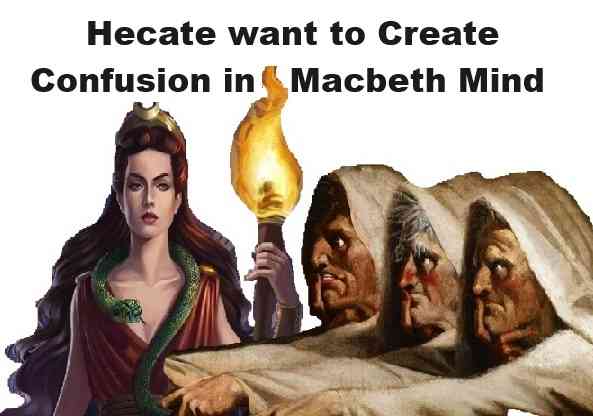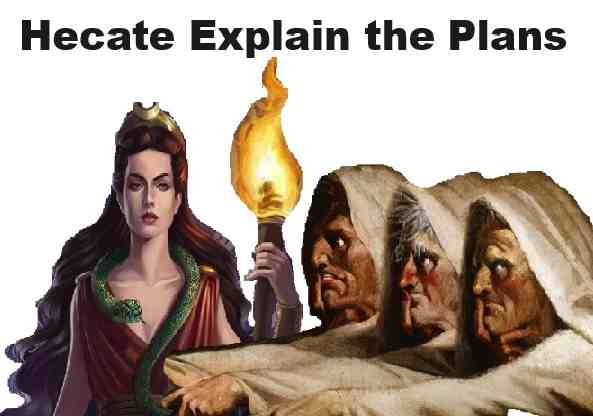Exe-5C and 5D Refraction Through Lens ICSE Class-10 Concise Selina Solutions Chapter-5. We Provide Step by Step Answer of Exercise-5(A), MCQs-5(A), Exercise-5(B), MCQ-5(B), Exercise-5(C), MCQ-5(C), Numericals -5(C) {Sign Conversion and Lens Formula} , Exercise-5(D) and MCQ-5(D) {Magnifying Glass And Application of Lenses} Questions of Exercise-5 Refraction Through Lens ICSEClass-10 . Visit official Website CISCE for detail information about ICSE Board Class-10.
| Board | ICSE |
| Publications | Selina Publication |
| Subject | Physics |
| Class | 10th |
| Chapter-5 | Refraction Through Lens (Exe-5C and 5D) |
| Book Name | Concise |
| Topics | Solution of Exercise-5(A), MCQs-5(A), Exercise-5(B), MCQ-5(B), , Exercise-5(C), MCQ-5(C), Numericals -5(C) , Exercise-5(D) and MCQ-5(D) |
| Academic Session | 2021-2022 |
Refraction Through Lens ICSE Class-10 Concise Physics Solutions Selina Publishers Chapter-5
-: Select Exercise :-
Exercise-5(A), MCQs-5(A), Exercise-5(B), MCQ-5(B),
Exe-5(C), MCQ-5(C), Numericals -5(C) , Exe-5(D) and MCQ-5(D)
Refraction Through Lens “Selina Physics Solution”
Exercise – 5 (c)
Page 126
Question 1
State the sign convention to measure the distances for a lens.
Answer 1
The axis along which the distances are measured is called as the principal axis. These distances are measured from the optical centre of the lens.
All the distances which are measured along the direction of the incident ray of the light are taken positive, while the distances opposite to the direction of the incident ray are taken as negative.
and All the lengths that are measured above the principal axis are taken positive, while the length below the principal axis is considered negative.
The focal length of the convex lens is taken positive and that of concave lens is negative.
Question 2 (Exe-5C and 5D Refraction Through Lens ICSE)
The focal length of a lens is (i) positive, (ii) negative.
In each case, state the kind of lens.
Answer 2
(i) The positive focal length of a lens indicates that it is a convex lens.
(ii) The negative focal length of a lens indicates that it is a concave lens.
Question 3
Write the lens formula explaining the meaning of the symbols used.
Answer 3
Lens formula:
![]()
where The distance of the object from the optical centre is called the object distance (u).
and The distance of the image from the optical centre is called the image distance (v).
The distance of the principal focus from the optical centre is called the focal length (f).
Question 4
What do you understand by the term magnification? Write expression for it for a lens, explaining the meaning of the symbols used.
Answer 4
The term magnification means a comparison between the size of the image formed by a lens with respect to the size of the object.
For a lens: Magnification ‘m’ is the ratio of the height of the image to the height of the object.

Question 5
What information about the nature of image (i) real or virtual, (ii) erect or inverted, do you get from the sign of magnification + or – ?
Answer 5
(i) Positive sign of magnification indicates that the image is virtual while negative sign indicates that the image is real.
(ii) Positive sign of magnification indicates that the image is erect while negative sign indicates that the image is inverted.
Question 6 (Exe-5C and 5D Refraction Through Lens ICSE)
Define the term power of a lens. In what unit is it expressed?
Answer 6
The power of a lens is a measure of deviation produced by it in the path of rays refracted through it.
Its unit is Dioptre (D).
Question 7
How is the power of a lens related to its focal length?
Answer 7
![]()
Question 8
How does the power of a lens change if its focal length is doubled?
Answer 8
If focal length of a lens doubled then its power gets halved.
Question 9
How is the sign (+ or -) of power of a lens related to its divergent or convergent action?
Answer 9
The sign of power depends on the direction in which a light ray is deviated by the lens. The power could be positive or negative. If a lens deviates a ray towards its centre (converges), the power is positive and if it deviates the ray away from its centre (diverges), the power is negative.
Question 10
The power of a lens is negative. State whether it is convex or concave?
Answer 10
It is a concave.
Question 11
Which lens has more power: a thick lens or a thin lens?
Answer 11
A thick lens has more power than a thin lens. This is because a thick lens has a larger surface curvature. It has a short focal lengthand that is why it deviates the rays of light at a greater extent.
Refraction Through Lens (Selina Publication )
Multiple Choice Type 5(C)
Page 126
Question 1
If the magnification produced by a lens is – 0.5, the correct statement is :
(a) The lens is concave
(b) The image is virtual
(c) The image is magnified
(d) The images is real and diminished formed by a convex
Answer 1
Magnification is -0.5. The negative sign of magnification indicates that the image is real while 0.5 indicates that the image is diminished. A convex lens only forms a real and diminished image of an object. Hence, the correct answer is option (d).
Question 5
The correct lens formula is

Answer 2
The correct lens formula is given by option (c).
![]()
Question 3 (Exe-5C and 5D Refraction Through Lens ICSE)
On reducing the focal length of a lens, its power:
(a) Decreases
(b) Increases
(c) Does not change
(d) First increases then decreases.
Answer 3
Increases
Hint ![]()
Question 4
The lens of power + 1.0 D is :
(a) convex of focal length 1.0 cm
(b) convex of focal length 1.0 m
(c) concave of focal length 1.0 cm
(d) concave of focal length 1.0 m
Answer 4
Power of a lens is +1.0 D. The positive sign indicates that the focal length of the lens is positive which indicates the lens is a convex lens.
Power is ![]()

Hence, the correct answer is option (b).
Refraction Through Lens Selina Physics Solution
Numericals 5 (C)
Page 126
Question 1
(a) At what position a candle of length 3 cm be placed in front of a convex lens so that its image of length 6 cm be obtained on a screen placed at distance 30 cm behind the lens?
(b) What is the focal length of lens in part (a)?
Answer 1
Height of the candle (object) = 3 cm
Height of the image of the candle = 6 cm
Image distance = 30 cm
(a) The formula for magnification of a lens is

(b) Lens formula is

Page 127
Question 2
A concave lens forms the image of an object kept at a distance 20 cm in front of it, at a distance 10 cm on the side of the object.
(a) What is the nature of the image?
(b) Find the focal length of the lens.
Answer 2
Object distance, u = -20 cm
Image distance, v = -10 cm
(a) The image is formed on the same side as the object. Hence, it is a virtual image. Also, since the lens is a concave lens the image will be erect and diminished.
(b) Lens formula is

Question 3
The focal length of a convex lens is 25 cm. At what distance from the optical centre of the lens an object be placed to obtain a virtual image of twice the size?
Answer 3
Focal length, f = +25 cm
Image is virtual and magnified, m = +2
For a lens, magnification is

Lens formula is,

Question 4
Where should an object be placed in front of a convex lens of focal length 0.12 m to obtain a real image of size three times the size of the object, on the screen?
Answer 4
Focal length of a convex lens, f = +0.12 m
m = -3 (real image)
For a lens, magnification is

Lens formula is,

Question 5 (Exe-5C and 5D Refraction Through Lens ICSE)
An illuminated object lies at a distance 1.0 m from a screen. A convex lens is used to form the image of object on a screen placed at distance 75 cm from the lens. Find: (i) the focal length of lens, and (ii) the magnification.
Answer 5
Image distance, v = 75 cm
Object distance, u = -25 cm
Lens formula is,

For a lens, magnification is

Question 6
A lens forms the image of an object placed at a distance 15 cm from it, at a distance 60 cm in front of it. Find: (i) the focal length, (ii) the magnification, and (iii) the nature of image.
Answer 6
Object distance, u = -15 cm
Image distance, v = -60 cm
(i) Lens formula is,

(ii) For a lens, magnification is

(iii) The nature of the image is erect, virtual and magnified.
Question 7
A lens forms the image of an object placed at a distance of 45 cm from it on a screen placed at a distance 90 cm on other side of it. (a) name the kind of lens. (b) find: (i) the focal length of lens, (ii) the magnification of image.
Answer 7
Object distance, u = -45 cm
Image distance, v = +90 cm
(a) As the image is formed on the other side of the lens, the image is real. Hence, the lens is a convex lens.
(b) (i) Lens formula is,

(ii) For a lens, magnification is

Question 8 (Exe-5C and 5D Refraction Through Lens ICSE)
An object is placed at a distance of 20 cm in front of a concave lens of focal length 20 cm. find: (a) the position of image, and (b) the magnification of image
Answer 8
Object distance, u = -20 cm
Focal length, f = -20 cm (concave lens)
(a) Lens formula is,

Hence, the image is 10 cm in front of the lens on the same side as the object.
(ii) For a lens, magnification is

Question 9
A convex lens forms an inverted image of size same as that of the object which is placed at a distance 60 cm in front of the lens. Find:
(a) The position of image, and
(b) The focal length of the lens
Answer 9
A convex lens forms an inverted, real and an image of the same size as the object when the object is placed at 2f, i.e. (u=2f).
(a) In such cases, the image is formed at the point which is double the focal length on the other side of the lens (2f2).
(b) To find the focal length of this lens, we use the relationship:
object distance (u) = 2f
object distance = 60 cm …(given)
60 = 2f
f = 30 cm
So, the focal length of this lens is 30 cm.
Question 10
A concave lens forms an erect image of 1/3rd size of the object which is placed at a distance 30 cm in front of the lens. Find:
(a) The position of image, and
(b) The focal length of the lens.
Answer 10
(a)
Given that the concave lens forms an erect image of 1/3rd size of the object.
That implies that the magnification provided by the lens is 1/3.
Magnification is given by
The position of the image formed is 10 cm on the same side of the lens where the object is placed.
(b)
Focal length of a lens is given by
The focal length of the given lens is 15 cm.
Question 11
The power of a lens is +2.0 D. Find its focal length and state what kind of lens it is?
Answer 11

Question 12 (Exe-5C and 5D Refraction Through Lens ICSE)
Express the power(with sign) of a concave lens of focal length 20 cm.
Answer 12

Question 13
The focal length of a convex lens is 25 cm. Express its power with sign.
Answer 13
Focal length, f = +25 cm = +0.25 m
Power of a lens is

Question 14
The power of a lens is -2.0 D. Find its focal length and its kind.
Answer 14
We know that power of a lens is given by the formula
As the power of the given lens is negative, i.e. -2.0 D, it is a concave lens.
Question 15
The magnification by a lens is -3. Name the lens and state how are u and v related?
Answer 15
The negative value of magnification suggests that image is real and inverted. The magnitude of magnification is greater than 1 which means image is enlarged. Therefore the lens should be convex lens.
Relation between u and v is given by

This shows that image distance is 3 times that of object distance.
Question 16
The magnification by a lens is +0.5. Name the lens and state how are u and v related?
Answer 16
The image formed by the concave lens is always virtual, erect and smaller than the object. Therefore the magnification is always positive and less than 1.

This shows that object distance is twice of image distance.
Question 17
A concave lens is a focal length 30 cm. Find the position and magnification (m) of image for an object placed in front of it at distance 30 cm. State whether the image is real on virtual?
Answer 17
Object distance=-30cm
Focal length=f=-3-cm
Image distance=v=?

Here image formed is virtual and erect.
Question 18 (Exe-5C and 5D Refraction Through Lens ICSE)
Find the position and magnification of the image of an object placed at distance of 8.0 cm in front of a convex lens of focal length 10.0 cm. Is the image erect or inverted?
Answer 18
Object distance=u=-8cm
Focal length f=10cm
Image distance v=?

As the object is placed between the focus and optical center of the lens the image formed is virtual and erect.
Selina Physics Solution Refraction Through Lens
Exercise 5(D)
Page 131
Question 1
What is magnifying glass? State its two uses.
Answer 1
Magnifying glass is a convex lens of short focal length.That is mounted in a lens holder for practical use.
Lens is used to see and read the small letters and figures and It is used by watch makers to see the small parts and screws of the watch.
Question 2
Draw a neat labelled ray diagram to locate the image formed by a magnifying glass. State three characteristics of the image.
Answer 2
Let the object (AB) is situated between focal length and optical centre of a convex lens then its image (A’B’) will form on the same side of lens.
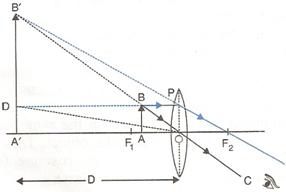
The image formed will be virtual, magnified and erect.
Question 3
Where is the object placed in reference to the principal focus of a magnifying glass, so as to see its enlarged image? Where is the image obtained?
Answer 3
The object is placed between the lens and principal focus.
The image is obtained between the lens and principal focus.
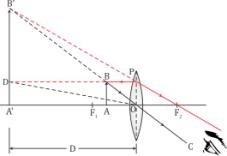
Question 4
Write expression for the magnifying power of a simple microscope. How can it be increased?
Answer 4
The magnifying power of the microscope is defined as the ratio of the angle subtended by the image at the eye to the angle subtended by the object (assumed to be placed at the least distance of distinct vision D = 25 cm) at the eye, i.e.,
![]()
where F is the focal length of the lens.
The magnifying power of a microscope can be increased by using the lens of short focal length. But it cannot be increased indefinitely.
Question 5 (Exe-5C and 5D Refraction Through Lens ICSE)
State two applications each of a convex lens and concave lens.
Answer 5
The two applications of a convex lens are:-
(i)It is used as an objective lens in a telescope, camera, slide projector, etc.
(ii)With its short focal length it is also used as a magnifying glass.
The two applications of a concave lens are:-
(i)A person suffering from short sightedness or myopia wears spectacles having concave lens.
(ii)A concave lens is used as eye lens in a Galilean telescope to obtain an erect final image of the object.
Question 6
Describe in brief how would you determine the approximate focal length of a convex lens.
Answer 6
The approximate focal length of a convex lens can be determined by using the principle that a beam of parallel rays incident from a distant object is converged in the focal plane of the lens.
In an open space, against a white wall, a metre scale is placed horizontally with its 0 cm end touching the wall.
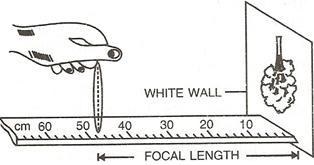
By moving the convex lens to and fro along the scale, focus a distant object on wall. The image which forms on the wall is very near to the focus of the lens and the distance of the lens from the image is read directly by the metre scale. This gives the approximate focal length of the lens.
Question 7
The diagram in Fig. shows the experimental set up for the determination of focal length of a lens using a plane mirror.

(i)Draw two rays from the point O of the object pin to show the formation of image I at O itself.
(ii)What is the size of the image I?
(iii)State two more characteristics of the image I.
(iv)Name the distance of the object O from the optical centre of the lens.
(v)To what point will the rays return if the mirror is moved away from the lens by a distance equal to the focal length of the lens?
Answer 7
(i)
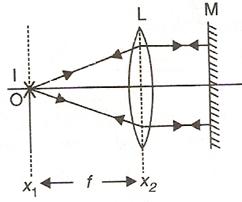
(ii)The size of the image will be same as that of object.
(iii)The image formed will be real and inverted.
(iv)The distance of object O from optical lens will be equal to the focal length of the lens.
(v)The position of the mirror from lens does not affect the formation of image as long as the rays from the lens fall normally on the plane mirror M.
Page 132
Question 8
Describe how you would determine the focal length of a converging lens, using plane mirror and one pin. Draw a ray diagram to illustrate your answer.
Answer 8
To determine focal length by using plane mirror we need a vertical stand, a plane mirror, a lens and a pin.
Place the lens L on a plane mirror MM’ horizontally. Arrange a pin P on the clamp of a vertical stand such that the tip of pin is vertically above the centre O of the lens.

Adjust the height of the pin until it has no parallax (i.e., when the pin and its image shift together) with its inverted image as seen from vertically above the pin.
Now measure the distance x of the pin from the lens and the distance y of the pin from the mirror, using a metre scale and a plumb line. Calculate the average of the two distances. This gives the focal length of the lens, i.e.,
![]()
Question 9 (Exe-5C and 5D Refraction Through Lens ICSE)
How will you differentiate between a convex and a concave lens by looking at (i) a distant object and (ii) a printed page?
Answer 9
(i) On seeing a distant object through the lens, if its inverted image is seen, then the lens is convex, and if the upright image is seen, then the lens is concave.
(ii) On keeping the lens near a printed page, if the letters appear magnified, then the lens is convex, and if the letters appear diminished, then the lens is concave.
Refraction Through A Lens
Multiple Choice Type – 5(D)
Page 132
Question 1
A magnifying glass forms:
(a) A real and diminished image
(b) A real and magnified image
(c) A virtual and magnified image
(d) A virtual and diminished image
Answer 1
A virtual and magnified image
Hint: A magnifying glass forms a virtual, magnified and upright image on the same side as the object.
Question 2
The maximum magnifying power of a convex lens of focal length 5 cm can be:
(a) 25
(b) 10
(c) 1
(d) 6
Answer 2
Focal length of convex lens, f = +5 cm
Magnifying power of convex lens (simple microscope) is
![]()
D is the distance of distinct vision, D = 25 cm
![]()
Return to Concise Selina ICSE Physics Class-10
Thanks

